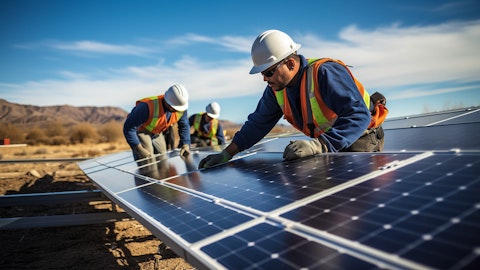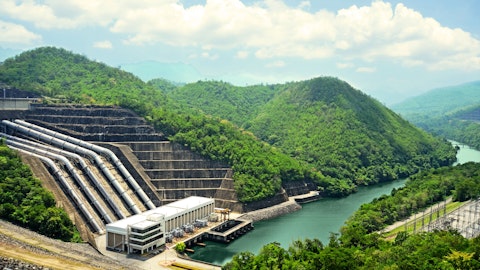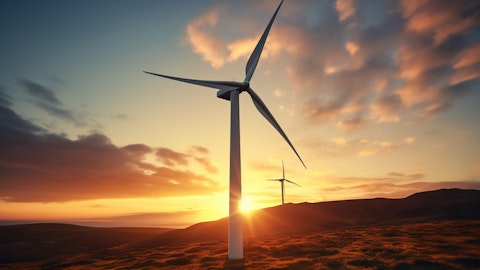Julian Mitchell: Good morning. Maybe just my question around renewables and sort of fully understand the offshore backlog, but maybe just wanted to focus on a couple of other things. One was are you seeing any shift in the kind of new orders on new equipment orders picture in renewables just because it seems a tougher environment for project development and financing in general across different industries, just wondered if your perspective on that had changed for the coming quarters. And sort of allied to that, because of the working capital dynamics of renewables with customer advances and so on, any thoughts around sort of what level of cash balance Vernova should have upon spin and sort of any mix of GE versus external financing for that or funding for that cash balance?
Larry Culp: Sure. Well, to start with, I think what we have seen through the course of the year, again, particularly with onshore and grid is just incredibly healthy demand despite the rate environment. Obviously, the incentives here, the incentives in Europe, the push with respect to the energy transition at large really has kept us very busy. So no change really whatsoever with respect to our commentary in that regard. I think as we look into the fourth quarter, as we look into ’24, any one project can move for various reasons. But I think we continue to be quite optimistic about the underlying demand that we see in those businesses. We know offshore has its own dynamics again to the reset comment I made a moment ago. But by and large, I think we’re feeling very good about the demand environment.
Rahul Ghai: And just to add to that, Julian, not only is the demand environment good, but as Larry kind of mentioned in his prepared remarks, we are seeing better pricing and the selectivity to strategy that Scott, Larry, Vic, or everybody has been pushing come through. Our grid backlog margins were up about three points and onshore backlog margins were up about seven points in the quarter. So that should obviously help through the turnaround efforts in 2024. So strong demand environment, good pricing on the renewables orders. Now switching to your second question on the cash balance, first and foremost, we do expect both Vernova and Aerospace to be investment grade at spin, right? So that’s kind of priority number one. And as we announced back in September that we do expect that Vernova will spin in a net cash position.
So we’re working through our framework on exactly what that number looks like. Obviously, what we want to do is we want to make sure that both companies have enough operating cash at the time of spin. In addition, what will also happen is as you probably noticed in our 10-Q, we have about $2 billion of restricted cash. And most of that is with Vernova right now as we think about where that cash balance is. So as we think about the cash balance at spin, it will be the restricted cash for both businesses plus the operating needs of that business. And there’s enough cash on the balance sheet at GE to make sure that this happens, and we definitely don’t need to tap into any external markets to make sure that both companies have enough cash at spin.
And we’ll give you an update as we get closer to spin.
Operator: Our next question comes from the line of Sheila Kahyaoglu with Jefferies.
Sheila Kahyaoglu: Thank you. Good morning, Larry and Rahul.
Larry Culp: Good morning.
Sheila Kahyaoglu: And Steve. Maybe if I could ask about aerospace margins. Same as last quarter, very good, 19.4 year-to-date, above 20% in the quarter, just help lift the guide up, which still implies a sequential step down in Q4. So the OE mix headwind with the 450 bps in the fourth quarter to hit the 1,650 is I guess a lot of it. Do you still expect 250 basis points of OE headwind this year? How does that filter into ’24 and the breakeven by ’26? Thank you.
Rahul Ghai: Okay. It’s a multipart question, Sheila. I’m going to try to remember everything. If I forget, just please jump in here. So you’re right. I think we had a good quarter, 25% revenue growth, 400 million profit growth, 120 basis points of margin expansion in the quarter continue to give us confidence to raise the year. So what we did in the quarter as you saw in the guide, we raised the guide for the year by about $500 million of revenue and slightly more than $250 million of profit. So about a 50% drop through for the incremental revenue. Obviously now part of that is the higher services revenue, lower OE revenue that you referenced. So as you kind of think about now what the fourth quarter looks like as you go from third quarter to the fourth quarter, there is about $200 million of incremental OE revenue.
And even though services revenue is still strong kind of mid teens, it is a lower sequential growth just given the timing of the spare part shipments. So that’s impacting the quarterly margin dynamic to a little bit. But having said all that, we’re still expecting kind of low 20% revenue growth in the year for GE Aerospace, about 1.2 billion to 1.3 billion of profit, close to a point of margin expansion as we end the year. So it will be a really, really good year. Now as you pointed out, LEAP deliveries are a little bit lighter than we had initially expected. Still a pretty substantial ramp in the fourth quarter we’re expecting. Based on the revised guidance that we just provided, we expect about a 15% growth from 3Q to 4Q and a pretty big ramp year-over-year.
Now some of the LEAP deliveries have pushed out into ’24 and ’25. So as we think about the outer year margins, we had guided to about a point of margin headwind from LEAP between ’23 to ’25. So now that will just be marginally higher, just movement of LEAP engine shipments from ’23 to ’24. I don’t know if I covered all the questions.
Operator: Our next question comes from the line of Deane Dray with RBC Capital Markets.
Deane Dray: Thank you. Good morning, everyone.
Larry Culp: Good morning, Deane.
Deane Dray: I was hoping if we could get some comments on the upside in free cash flow this quarter and the progress that you’re making in having free cash flow more linear through the year? It looks like that’s working. And any comments on the dynamics we should expect for free cash flow in the fourth quarter. Any puts or takes?
Larry Culp: Deane, thanks for noticing, right, to be up $1 billion in the quarter year-over-year; to be at, what, 2.2 here year-to-date, this was the time of the year in years past where we were kind of holding our breath waiting for all the cash flow in the year to come in, in the fourth quarter. I think what you see again is a much more linear approach to running the business coupled with obviously steady demand through the course of the year, both at Aero and across Vernova. So much of what we’ve tried to do in moving away operationally from the year end dynamics, let alone the quarter end dynamics, I think has borne some fruit. But we are far from I’ll say a perfectly level loaded business at both Aerospace and Vernova. But we know as we continue to make progress, there will not only be the positive cash effects that you’re pointing at.
But frankly, there’s a lot of cost we think we can pull out over time as well as we drive greater linearity and have less month end, quarter end, year-end sprints, which we know we can do, but we rarely do efficiently.





